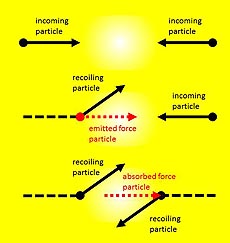Sacks and boats: subatomic forces
 |
| At the subatomic level, forces appear because one matter particle emits a force particle. When you throw a heavy sack off a boat, the boat recoils. Similarly, when one particle emits another one, the original particle recoils (moves). This is fundamentally how forces work at the subatomic level. Image courtesy of Dan Claes
|
Particle physicists explore the subatomic realm, which consists of quarks, leptons and the four forces that govern them. These forces are the strong nuclear force, the electromagnetic force, the weak nuclear force and gravitational force.
Over the next few weeks, we will be describing each of these forces and how they behave. Today we'll look at some commonalities to understand what particle physicists mean when they use the term "force" and what we know about how these forces behave in the microworld.
The word force has a technical meaning in an introductory physics class. According to Newton's laws, a force changes the velocity of an object. Hitting the accelerator or brake pedal in your car will cause it to speed up or slow down. Each of these two actions, therefore, applies a force to the car. You can also change the velocity by changing direction. By turning the steering wheel of your car, you can make the car move left or right through the force between the tires and the road.
However, in everyday usage, the term force refers to something that can bring about change not just in velocity, but in general. An example is a military force toppling a government, inducing a change in the country's politics. When describing the forces between subatomic particles, particle physicists use a more general meaning like this one. While forces can certainly alter the trajectory of a particle or change its energy, they can also cause particles to combine, decay or change their identities. Thanks to subatomic forces, a photon can disappear and an electron and antimatter electron can appear in its place. In the subatomic world, forces induce many kinds of change.
 |
| In a particle collision, two particles approach one another (top). The collision begins when one of the particles emits a force-carrying particle and then recoils (middle). The collision is complete when the second particle absorbs the force-carrying particle and also recoils (bottom). Note that the actual process whereby this occurs requires some quantum insights and is more subtle than this. However, this simplified version illustrates the most important points.
|
A class of theories called quantum field theories, or QFTs for short, describes the way that forces are induced in particle collisions. A basic property of these theories is that they replace the force fields of classical physics with quantum fields. For instance, in the quantum field formulation, Earth's gravitational field is treated as having lots of tiny force-carrying particles buzzing around. By way of analogy, think of air. We know what air is like—it's everywhere. However, we also know of air molecules, which can be considered quanta of air. The QFT approach focuses on the "atoms" of the force.
The scattering of subatomic particles can be calculated using the QFT formalism. Take the simple case of scattering two electrons. In the classical approach, the two electrons feel a repulsive force due to their respective electric fields. However, in the QFT approach, the force is caused by the exchange of a force-carrying particle. In this example, the force-carrying particle is a photon: one electron emits a photon, which is absorbed by the other one.
To understand how this works, imagine two people standing in nearby rowboats. If one person throws a heavy sack from one boat toward the other person, the throwing person's boat will recoil. If the second person catches the sack, that boat will also move. Because of the exchange of the sack from one boat to the other, the two boats will move away from one another. This action is the fundamental origin of the separating force between the two boats. In the same way, the exchange of a force-carrying particle can scatter two matter particles in a collision.
We can extend this analogy to other changes. For instance, the individual throwing the sack could also toss a yellow raincoat or a silly hat to the other person, so transferring these properties to the other. It is even possible to use this analog to explain attractive forces, although this stretches the boat analogy a little bit. In the following weeks, we will discuss how these ideas of particle exchange apply to the four known forces.
—Don Lincoln
Want a phrase defined? Have a question? E-mail today@fnal.gov.
|